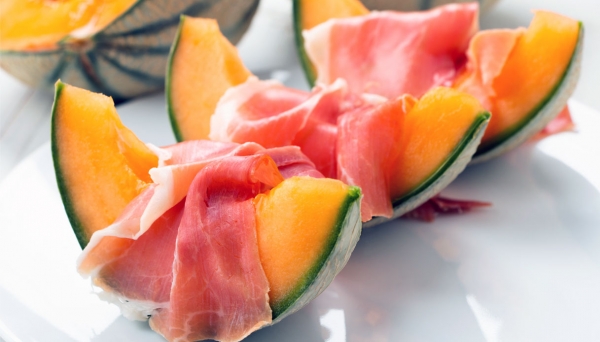Also because, living not far from Parma, now and then I take a little trip there to satisfy my desire, not only of ham but also of parmesan, culatello, tortellini, salame and many other specialities. And when it comes to building an itinerary, I always try to include Parma, because I know it will be an unforgettable stop. Thus, I'll try to explain to you why raw ham is so popular, for me and millions of Italians.
First of all, as always in Italy, some history. Raw ham is the heir to a thousand-year-old tradition of several peoples of the past, who needed food that could be preserved over time without turning bad. The same word "ham" likely comes from a Latin term, perexsuctum, which means precisely "dry, deprived of liquids": this word would indicate the loss of water due to the use of salt in its preparation and the subsequent ageing process. Raw ham has been produced from the ages of the Greeks and Romans. In 2nd century B.C., Cato wrote about the method for preserving pig's thighs by salting and seasoning. Etruscans were famous for their ability to season and smoke meat. The Gauls of the Po Valley, a land rich in water, forest, acorns and chestnuts, were also very skilled in raising pigs and processing meat, and in Rome they imported large quantities of it.
In ancient times salt was very valuable, it was often used as a form of payment for Roman legionnaires (hence the Italian word 'salario', salary). This value was linked to its rarity and the multiplicity of its uses, all of which were very important, among them the preservation of food.
Romans found that the ancestor of 'ham' was particularly suited to feed their legions. Prosciutto, not needing cooking, allowed the armies to enjoy extreme mobility while ensuring a correct nutritional intake. It is said that during the campaign of Italy the Carthaginian General Hannibal, immediately after defeating the Roman army at the Battle of the Trebbia river near Parma (218 BC), was welcomed by the citizens of the city who offered him their most precious food, namely the salted thighs of pork.
With the fall of the Empire, the Longobards perpetuated the tradition. With the invasions of the barbarians, pigs became one of the most important resources of the villages, and so hams, shoulders, bellies were even used as a means of exchange. In the Middle Ages, the grazing of pigs was so important that forests were measured according to their ability to feed pigs. From the 12th century, meat processing developed fast and according to various sources the production of cured meats was among the main activities of the time. At the beginning of the 19th century, the first food workshops and the first charcuterie began to spread, and Italian charcuterie and hams became famous worldwide, thanks to the propaganda of foreign tourists who appreciated its quality and the great variety of tastes.
Prosciutto, as we know it today, is therefore the result of the centuries-old evolution of this technique, however its quality originates from the raw material. First of all, the pigs selected for the production of the most famous Italian DOP (“Denominazione di Origine Protetta”, Denomination of Protected Origin), all Italian purebred, are born and raised in North-Central Italy. They are fed selected cereals, mainly maize and barley, so that their meat is always constant in quality and with the right proportions between muscle and fat, and are slaughtered at about 9 months of age, weighing around 160 kg.
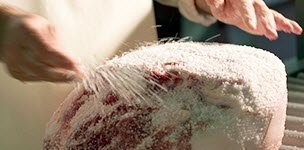
Starting from the raw material, the path to our table is very long and requires a great mastery in the various stages of preparation. They let thighs rest for about 24 hours at 0°C so that it firms up, helping to remove fat and rind. This is how its rounded shape is created. Then, salting with sea salt, twice with a 7-day interval, after that thighs rest for two or three weeks. After eliminating residual salt, thighs rest for another three months, after which they hang and beat them. Then, “sugnatura”, that is the protection of the muscle with pork fat, salt and pepper, which helps the meat to get soft and tasty. After the first 7 months from the start of the process, the ham will be seasoned for at least another 12 months. Strange as it may seem, despite the technological developments of our times, the most important tool for 'testing' the quality of ham is the 'fibula', a thin awl, made with the bone of a horse's shin, which is used by the 'spillatore' to penetrate the ham at specific points, between the muscle and the fat part, and in different places of the muscle mass. The horse's bone is perfect, thanks to its porosity, to capture scents and then lose them in a short time. Thanks to these scents the “spillatore”, like a sommelier, can evaluate the characteristics of the ham, too dry, too salty or too sweet.

I already told about the variety of food in Italy and its historical reasons, and Prosciutto Crudo is no exception. You can taste the Jambon de Bosses of Val d'Aosta, the “Crudo di Norcia” in Umbria, the “Crudo di Faeto” in Puglia, and then the “Sicilian” of the Nebrodi and the “Crudo di Val Vigezzo” in Piedmont, from pigs that graze freely in the pasture. However, Parma, San Daniele and the Classic Tuscan Ham are the most popular.
Parma ham is born in a very limited area in the province of Parma, south of the Via Emilia, whose characteristic climatic conditions guarantee a perfect drying and seasoning. If you visit Parma, you will see large buildings with windows facing south: they receive sweet air scented by the sea of Liguria and filtered through the woods of the Apennine Mountains. Each Parma Ham has a mark with a five-pointed crown (the Ducal Crown): by this mark the members of the Consortium certify the origin of the Prosciutto, ensuring the compliance with the production discipline and, ultimately, its quality. Parma ham is persistent and sweet, with nuances ranging from honey to candied citrus and spicy black pepper.
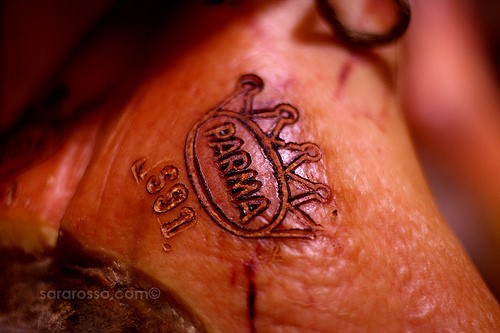
San Daniele Ham from Friuli (North-Eastern Italy) is seasoned by the Adriatic breeze mixing with the air of the Alps and is very soft and sweet. The dry air of the hills of San Daniele makes it ripen earlier than Parma so that with the same seasoning time the Friulano ham will seem more mature than Parma.
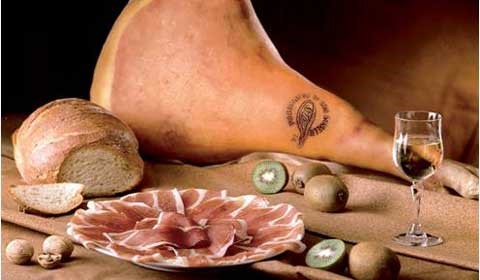
Without being disrespectful, my favourite ham, but only because my grandfather was Tuscan, is the Classic Tuscan ham. Its strong taste is due to the addition, during salting, of natural Tuscan essences and aromas such as garlic, rosemary, juniper and myrtle.
But what is the correct way to cut Prosciutto? Here, too, there is a difference. With Parma and San Daniele hams, you’d better use a slicer. The ideal thickness of the slices is comparable to a sheet of paper (you would never be able to cut it so by hand). Instead, Tuscan and other hams, given their consistency, are usually cut by a knife, which is also more scenic. Therefore in Tuscany and Central Italy, you will mostly eat ham cut with a knife. Be careful, however, not to eliminate fat: the presence of fat enhances the scent and flavour of the ham.
At the end of this dissertation, it's time to taste these masterpieces. You can eat Parma and San Daniele alone as well as with a kind of pizza, the “Piadina”, typical of the Coast of Romagna, east of Bologna. Piadina is the queen of Italian street food, loved by millions of people around the world; in the most traditional recipe, ham is stuffed inside piadina with rocket and squacquerone, a creamy cheese similar to “stracchino”.
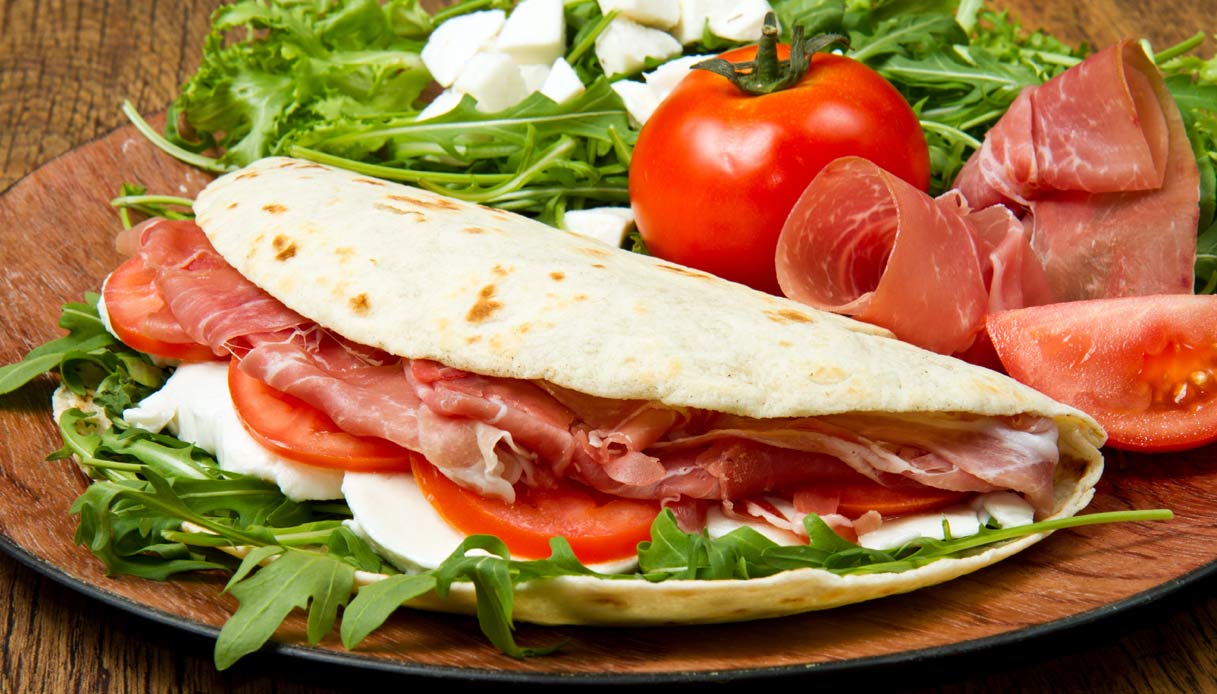
Instead, the best way to taste Tuscan ham is enclosed between 2 slices of homemade Tuscan bread, which is saltless. With the soft white interior and the crunchy golden crust, all watered down with a good glass of red wine. Tuscan ham is also fantastic with figs, a custom dating back to the Middle Ages when the first course was fruit.
We're in summer, so the summer dish by definition is “Prosciutto e Melone” (Ham and Melon). Its sweet, perfumed taste suits the ham flavor perfectly. The melon should be served cold with the zest, while ham should be laid out in slices.
And the wine? With Parma and San Daniele, definitely white. Firm or sparkling, it’s the best pairing. Parma ham is sweet, with a good fat part and some flavor. The Malvasia dry wine is perfect for degreasing. In Parma, however, you will gladly drink Lambrusco, a sparkling light red. If you prefer Tuscan ham, do as Tuscans do, a nice glass of Chianti is always the best choice.
Did you get your mouth watering? I do. I really have to take a trip to Parma soon.
Ciao da Marcello
